The idea of a spiderweb cheesecake might seem a bit whimsical, but it’s really a story of patience and detail. I fell for it during a holiday baking spree, drawn by the intricate design and the promise of creamy richness beneath. It’s not just dessert; it’s a conversation starter, a piece of edible art that feels special without needing fancy ingredients.
Why I Keep Returning to This Cheesecake
Its blend of precision and creativity keeps me hooked. Each time I make it, I find new ways to tweak the web design or filling spices. It’s a reminder that beauty and flavor can coexist in the kitchen, demanding patience and pride with every layer. Plus, the compliments when I serve it are worth every minute of effort.
Deconstructing the Spiderweb Cheesecake
- Graham crackers: Provide a crunchy, buttery base. Sub with digestive biscuits if unavailable.
- Butter: Bind the crust together with richness and flavor. Use margarine for a dairy-free version.
- Cream cheese: The creamy core, smooth and tangy. Full-fat gives the best texture.
- Sugar: Sweetens the filling and balances acidity. Honey can replace part of it for a floral note.
- Eggs: Help set the filling. Use flax eggs for a vegan take.
- Sour cream: Creates the web’s decorative topping with a tangy zing. Yogurt works in a pinch.
- Powdered sugar: Sweetens and thickens the topping. Adjust to taste.
Tools for Your Web of Cheesecake Creation
- Springform pan: Gives you a clean edge and easy removal for presentation.
- Mixing bowls: Combine ingredients smoothly and efficiently.
- Electric mixer or whisk: Beat the cream cheese and eggs to a silky texture.
- Toothpick or skewer: Create the web pattern on top.
- Spatula: Spread the topping evenly and handle delicate layers.
Steps to Craft Your Spiderweb Cheesecake
Step 1: Preheat your oven to 160°C (320°F).
Step 2: Mix crushed graham crackers with melted butter and press into a 20cm (8-inch) springform pan, creating a thin, even crust.
Step 3: Beat softened cream cheese with sugar and vanilla until smooth, then add eggs one at a time, mixing just until incorporated.
Step 4: Pour the filling over the crust and bake for about 50-60 minutes until the edges are set but the center still jiggles slightly.
Step 5: While baking, prepare the spiderweb topping: mix sour cream with powdered sugar and a splash of vanilla.
Step 6: Once the cheesecake is out of the oven, let it cool in the pan for 30 minutes. Then refrigerate for at least 4 hours, ideally overnight.
Step 7: Before serving, spread the sour cream mixture on top and use a toothpick to create a web pattern, starting from the center outward.
Key Checks to Keep Your Spiderweb Cheesecake Perfect
- Ensure the crust is pressed firmly and evenly to prevent cracks.
- Bake until edges are lightly golden and the center jiggles just slightly, avoiding overbaking.
- Create the web pattern when the topping is slightly set but still flexible to prevent smudging.
- Refrigerate thoroughly to help the web firm up and set the design for clean slicing.
Common Mistakes and How to Fix Them
- Overmixing the filling can cause cracks.? CRACKED TOP? — Bake at a slightly lower temperature and avoid overmixing the filling.
- Creating the web too early causes smudging.? WEB RUNNING? — Let the topping set for a few minutes before drawing the web.
- Not refrigerating long enough or oven temperature inaccuracies.? CHEESECAKE TOO SOFT? — Chill longer or check oven temp with an oven thermometer.
- Over-pressing the crust or using too much butter.? CRUSTS TOO HARD? — Use slightly less butter or press more gently.
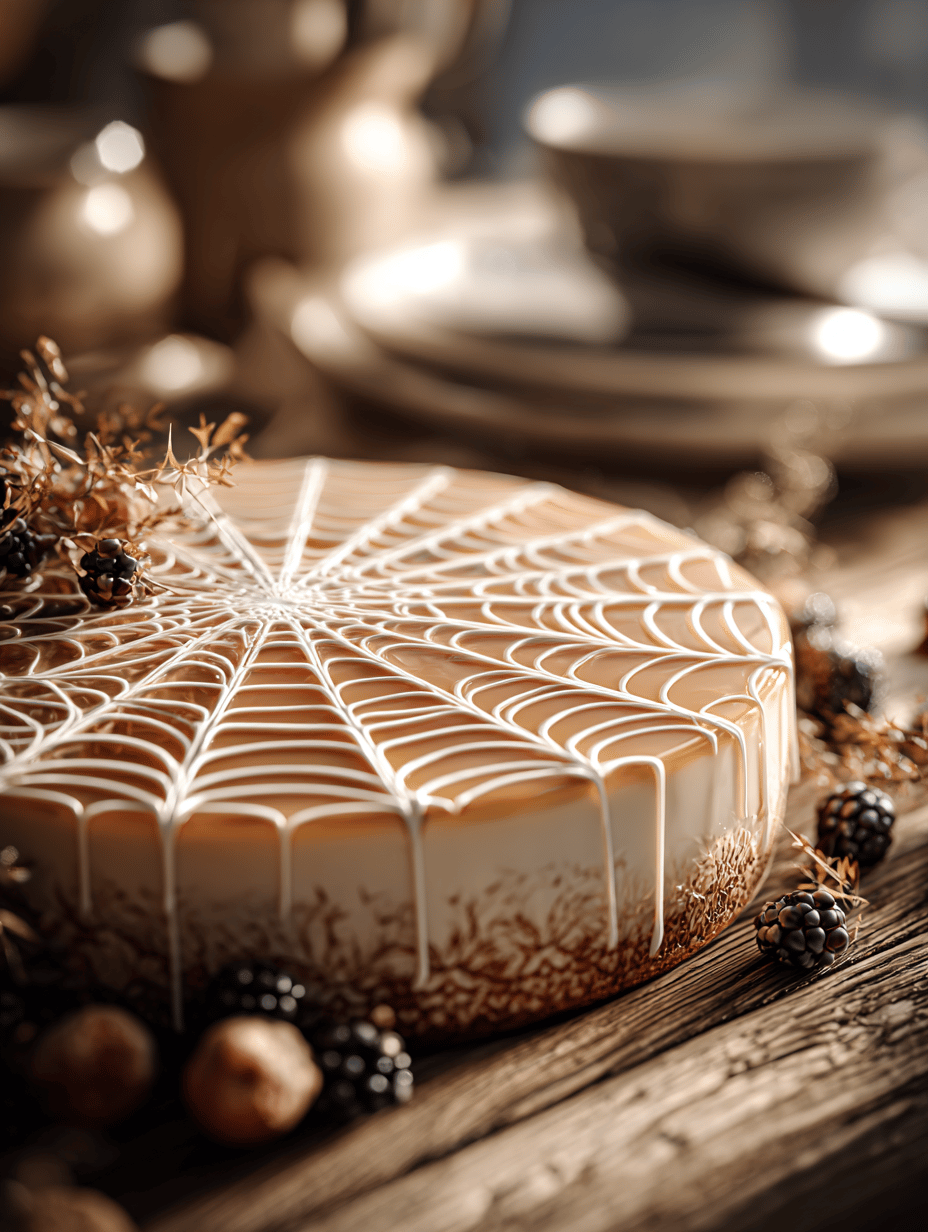
Spiderweb Cheesecake
Ingredients
Equipment
Method
- Preheat your oven to 160°C (320°F). Mix graham cracker crumbs with melted butter until evenly coated, then press this mixture firmly into the bottom of a 20cm (8-inch) springform pan to form a smooth crust. Bake for 10 minutes, then set aside to cool.
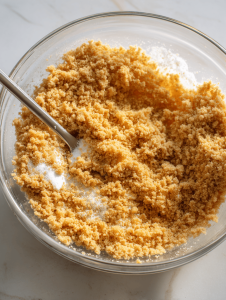
- In a large mixing bowl, beat softened cream cheese with sugar and vanilla until smooth and creamy. This creates a silky filling base with a slight tang.
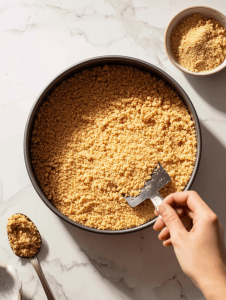
- Add eggs one at a time to the cream cheese mixture, beating just until each is incorporated. The mixture should be thick and smooth, with no streaks.
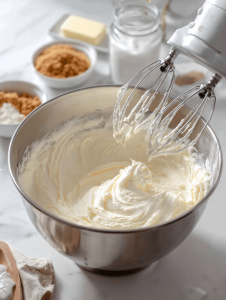
- Pour the filling over the cooled crust, smoothing the top with a spatula. Bake for 50-60 minutes until the edges are lightly golden and the center jiggles slightly when moved.
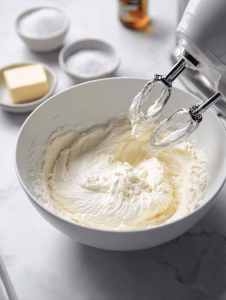
- While the cheesecake bakes, mix sour cream with powdered sugar and a splash of vanilla until well combined. This will be used for the web decoration.
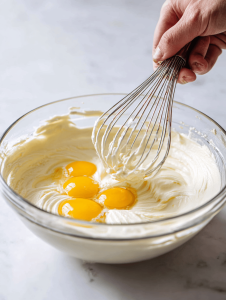
- Once baked, turn off the oven and let the cheesecake cool in the pan for about 30 minutes, then transfer it to the refrigerator to chill for at least 4 hours or overnight. This helps it set and develop a smooth texture.
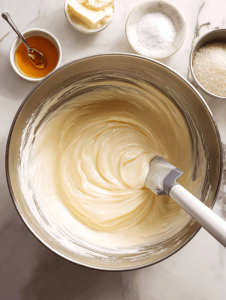
- Spread the sour cream mixture evenly over the chilled cheesecake, creating a smooth top surface. Use a spatula to get a clean, flat finish.
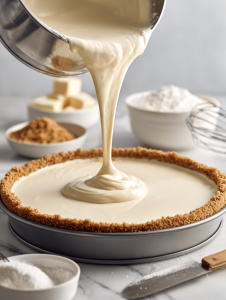
- Using a toothpick or skewer, starting from the center, draw lines outward to create a web pattern. Repeat from the center to the edges, forming concentric circles for the web design.
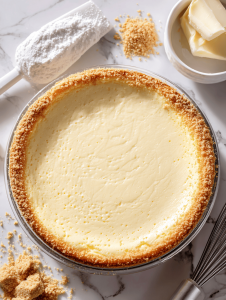
- Finish by gently dragging the toothpick from the center outward along the lines to enhance the web effect. The pattern should look delicate and symmetrical, adding an artistic touch to your cheesecake.
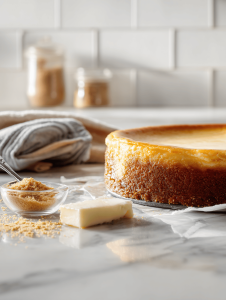
- Slice the cheesecake carefully with a sharp knife, wiping it clean between cuts for neat slices. Serve chilled to enjoy the creamy texture and impressive design.
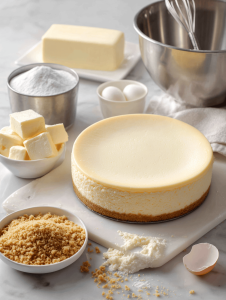
Leave a Reply